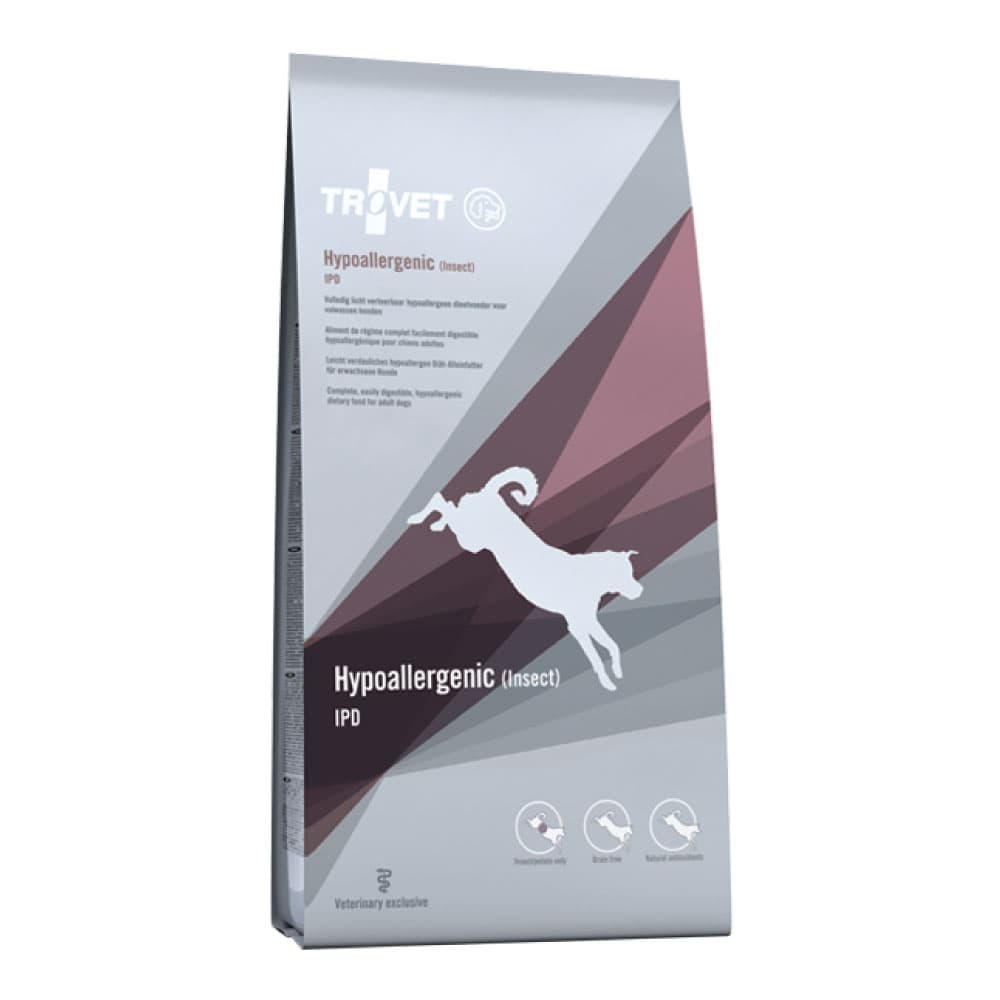Food
Trovet - The King of Hypoallergenic & Veterinary Diets.

Goal
The goal of this trial was to gain insight into the palatability and immunogenicity of a hypoallergenic dietary food based on insects and potatoes in dogs with suspected or proven food intolerance and/or allergy.
Materials and methods
Several veterinarians and dermatology specialists in the Netherlands were asked to participate in a trial for dogs feeding hypoallergenic food containing insects as a protein source. The trial lasted six weeks.
Selection procedure
The veterinarians and specialists were asked to include adult dogs with proven food hypersensitivity in the trial.
The following exclusion criteria were used:
• Dermatitis due to contact, house dust mite or flea allergies
• Non-allergy related skin disorders
• Dogs that have completed a Prednisone treatment in
the past two weeks
• Dogs that are on medication
38% 62%
fig. 1: Recruided patients
Veterinarians Specialists
• Chronic stomach/intestinal disorders, not related to food hypersensitivity
• Pancreatitis
• Exocrine pancreatic insufficiency • Extreme overweight
Animals
A total of 38 adult dogs participated in the trial. All dogs were privately kept. The ages ranged from one to fourteen years of age. A total of 28 different breeds participated in the trial.
Food
The recommended amount of daily food was based on the average energy requirement calculation (kcal/day): 110^(kg BW)0,75 and was later individually adjusted on owner observations and experience.
Scoring
Scoring was done by the owners. Observational scores of faeces, flatulence, itching symptoms, damaged skin and damaged coat were made. The first score (week 0) was done before the start of the feeding trial, to assess the condition of the dog when fed their original diet. The scores were based on a weekly average of observations.
Results
A total of 38 dogs participated in the trial. Two dogs did not complete the trial, because of poor palatability of the food. The results of two dogs were never received. Two dogs did not complete the trial due to a private situation and were not included in the results. Seven more dogs were excluded from the results, due to a violation with the inclusion/exclusion criteria.
The results of a total of 25 dogs, that met all the inclusion criteria, were analysed. Three dogs showed no improvement or a partial improvement of the clinical signs of food hypersensitivity. In 21 dogs, a clear reduction of scratching, biting and licking of the limbs and skin/coat was observed. One dog worsened during the trial and stopped in week four of the trial. All dogs with reduced itching symptoms showed an improvement in skin and coat condition. Nine out of the ten dogs with soft stool at the start of the trial, had a more firm and well formed stool during the course of the trial. In all but one dog, flatulence and vomiting completely disappeared or was absent during the entire trial period.
Discussion
For the dogs that did not show any improvement, it could be possible that the trial period was too short to show any sign of improvement. Furthermore, there was also the possibility that these dogs fell within the exclusion criteria, thus having other diseases/illnesses other than food hypersensitivity. The one dog that worsened could have been allergic to the Black Soldier Fly larvae. Even though the chance is very small, this possibility should not be excluded. The dogs that developed a less formed stool during course of the trial, without showing any other hypersensitivity symptoms, might have been intolerant to one of the ingredients in the diet.
Conclusion
The (vast) majority of the dogs that completed the trial showed a clear reduction in itching symptoms and an improvement in skin and coat condition. Next to this, all dogs with an improved skin and coat condition also had reduced gastro-intestinal problems. Based on the observations in this trial, it is safe to conclude that Hypoallergenic (Insect) | IPD is a suitable diet for dogs with food hypersensitivity.



